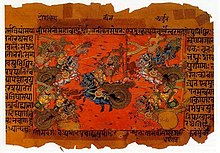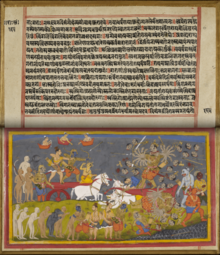692:. Sanskrit Text and English Translation. Poona: The Oriental Book-supplying Agency)|quote=It springs from a historical incident or is otherwise based on some fact; it turns upon the fruition of the fourfold ends and its hero is clever and noble; By descriptions of cities, oceans, mountains, seasons and risings of the moon or the sun; through sportings in garden or water, and festivities of drinking and love; Through sentiments-of-love-in-separation and through marriages, by descriptions of the birth-and-rise of princes, and likewise through state-counsel, embassy, advance, battle, and the hero's triumph; Embellished; not too condensed, and pervaded all through with poetic sentiments and emotions; with cantos none too lengthy and having agreeable metres and well-formed joints, And in each case furnished with an ending in a different metre—such a poem possessing good figures-of-speech wins the people's heart and endures longer than even a kalpa.
115:
135:
73:
402:
contains the whole list, which, if one considers it carefully, will be seen to contain the basic repertory of
Sanskrit poetry. Contained in it are the essential elements of nature, love, society, and war which a poet should be able to describe. The great kāvya tested a poet by his power of rendering
385:
It must contain descriptions of cities, seas, mountains, moonrise and sunrise, and "accounts of merrymaking in gardens, of bathing parties, drinking bouts, and love-making. It should tell the sorrow of separated lovers and should describe a wedding and the birth of a son. It should describe a king's
407:
It is composed of a varying number of short poems or cantos, that tells the story of a classical epic. Each poem is composed in a metre that is fitting to the subject matter, such as a description of the seasons, a geographical form of nature such as a mountain, and cities.
564:
Yoshichika Honda. 'Indian
Buddhism and the kāvya literature: Asvaghosa's Saundaranandakavya.' Hiroshima Daigaku Daigakuin Bungaku Kenkyuuka ronshuu, vol. 64, pp. 17–26, 2004.
445:
On the other hand, the number of authors who appear to be very enthusiastic about writing in
Sanskrit during these days is not negligible. In a thesis dealing with Sanskrit
438:
723:
430:
775:
182:
420:
164:
819:
234:
160:
17:
793:
578:
472:
463:
s do not aim to satisfy all the traditional criteria, and take as their subject historical matter (such as
403:
content, which is a better test at least than the
Persian diwan, which tested a poet by his skill at rhyme.
814:
761:
156:
704:
532:
145:
149:
53:
and so on — in short, everything that tests a poet's skill at description. Typical examples of
338:
313:
739:
713:
527:
565:
375:
It must take its subject matter from the epics (Ramayana or
Mahabharata), or from history,
8:
508:
464:
386:
council, an embassy, the marching forth of an army, a battle, and the victory of a hero".
84:
42:
38:
601:
114:
800:
The
Ramayana : In Classical Sanskrit and Prakrt Mahakavya Literature/V. Raghavan
771:
719:
293:
269:
249:
58:
517:
476:
221:
and was influential enough to be translated into both
Tibetan and Chinese. Another
226:
196:
767:
679:
596:
512:
451:
s written in a single decade, 1961–1970, the researcher has noted 52 Sanskrit
447:
360:
45:. The genre is characterised by ornate and elaborate descriptions of scenery,
808:
488:
281:
274:
254:
207:) is one of the earliest Sanskrit poets with surviving Kāvya literature. His
65:
346:
and simultaneously illustrates the principles of
Sanskrit grammar, 22 cantos
522:
394:
These are not random suggestions but specific requirements. Every complete
379:
209:
103:, a total of about 1500-3000 verses), they are still much shorter than the
799:
687:
662:
656:
649:
643:
636:
630:
623:
617:
610:
108:
88:
76:
555:, Oxford, Clarendon 1894, reprint: New Delhi, 1977, p. X (introduction).
500:
322:
298:
204:
715:
An
Anthology of Sanskrit Court Poetry: Vidyākara's Subhāṣitaratnakoṣa
675:
306:
289:
in 6th century CE: Arjuna's encounter with a Kirata (Shiva) 18 cantos
609:) 1.15–19:|quote= itihāsa-kath’’-ôdbhūtam, itarad vā sad-āśrayam, |
134:
399:
343:
118:
104:
92:
318:
496:
326:
286:
262:
425:
In the relatively secluded world of modern
Sanskrit literature,
359:
genre, more emphasis was laid on description than on narration.
484:
429:
s continue to be produced. Some of these have been awarded the
50:
72:
258:
222:
100:
796:
English translation by K. K. Handiqui (includes glossary)
342:, by Bhaṭṭi in 7th century CE: describes the events of the
302:
46:
535:
continue to have the subject of the traditional epics.
651:
sargair an-ativistīrṇaiḥ, śravya-vṛttaiḥ su-saṃdhibhiḥ
759:
421:
Sanskrit literature § Modern Sanskrit literature
487:), or biographies of historical characters (such as
763:Ṣoḍaśī: An Anthology of Contemporary Sanskrit Poets
435:Ṣoḍaśī: An Anthology of Contemporary Sanskrit Poets
333:To this list, sometimes a sixth one is also added.
718:. Harvard University Press. 1945. pp. 33–35.
83:It is considered the most prestigious form in the
632:vipralambhair vivāhaiś ca, kumār’-ôdaya-varṇanaiḥ
806:
658:sarvatra bhinna-vṛttāntair upetaṃ, loka-rañjanam
87:. The genre evolved from the earlier epics, the
645:alaṃ-kṛtam, a-saṃkṣiptaṃ, rasa-bhāva-nirantaram
612:catur-varga-phal’-āyattaṃ, catur-udātta-nāyakam
686:1.15–19 (S. K. Belvalkar. 1924. Kāvyādarśa of
664:kāvyaṃ kalp’-ântara-sthāyi jāyate sad-alaṃkṛti
638:mantra-dūta-prayāṇ’-āji-nāyak’-âbhyudayair api
33:(lit. great kāvya, court epic), also known as
625:udyāna-salila-kṛīḍā-madhu-pāna-rat’-ôtsavaiḥ
455:s (epic poems) produced in that very decade.
378:It must help further the four goals of man (
553:The Buddha Carita or the Life of the Buddha
367:lists the traditional characteristics of a
163:. Unsourced material may be challenged and
398:that has come down to us from the time of
700:
698:
240:Tradition identifies five works as model
183:Learn how and when to remove this message
669:
113:
71:
753:
265:, and the birth of Kumara, in 17 cantos
14:
807:
695:
590:
233:, which focuses on the conversion of
124:
709:Sanskrit Poetry and Sanskrit Poetics
161:adding citations to reliable sources
128:
760:Radhavallabh Tripathi, ed. (1992),
411:
390:About this list, Ingalls observes:
107:(500 cantos, 24000 verses) and the
24:
576:
431:Sahitya Akademi Award for Sanskrit
350:
321:in 7th century CE: the slaying of
277:, in 19 cantos (about 1564 verses)
257:in 5th century CE: the wedding of
195:The Buddhist poet and philosopher
25:
831:
787:
732:
329:, 22 cantos (about 1800 verses)
301:in 1174 AD: on the life of King
133:
586:. Lahore: University of Panjab.
570:
558:
545:
13:
1:
538:
473:Indian independence movement
7:
688:
663:
657:
650:
644:
637:
631:
624:
618:
611:
27:Indian genre of epic poetry
10:
836:
418:
742:. Encyclopædia Britannica
533:Jagadguru Rāmabhadrācārya
433:. In the introduction to
237:, Buddha's half-brother.
619:nagar’-ârṇava-śaila’-rtu
577:Johnston, E. H. (1928).
525:). Some others like the
95:. Despite the length of
111:(about 100000 verses).
820:Epic poems in Sanskrit
457:
405:
121:
80:
794:The Naishadha-charita
528:Śrībhārgavarāghaviyam
443:
439:Radhavallabh Tripathi
392:
117:
79:the longest Mahakavya
75:
607:The Mirror of Poetry
551:E.B. Cowell, trans.
469:Svatantrya Sambhavam
157:improve this section
531:(2002) composed by
509:Bal Gangadhar Tilak
505:Sritilakayasornavah
493:Shrishivarajyodayam
465:Rewa Prasad Dwivedi
85:Sanskrit literature
711:, Introduction to
678:'s translation of
483:on the history of
215:Acts of the Buddha
125:Classical examples
122:
81:
43:Classical Sanskrit
39:Indian epic poetry
815:Indian literature
725:978-0-674-78865-7
273:by Kālidāsa: the
217:) calls itself a
193:
192:
185:
16:(Redirected from
827:
781:
780:
757:
751:
750:
748:
747:
736:
730:
729:
702:
693:
691:
673:
667:
666:
660:
653:
647:
640:
634:
627:
621:
614:
594:
588:
587:
585:
574:
568:
562:
556:
549:
518:Kristubhagavatam
477:K.N. Ezhuthachan
202:
188:
181:
177:
174:
168:
137:
129:
37:, is a genre of
21:
835:
834:
830:
829:
828:
826:
825:
824:
805:
804:
790:
785:
784:
778:
768:Sahitya Akademi
758:
754:
745:
743:
738:
737:
733:
726:
712:
703:
696:
674:
670:
655:
642:
629:
616:
595:
591:
583:
575:
571:
563:
559:
550:
546:
541:
423:
417:
353:
351:Characteristics
294:Naiśadha-carita
200:
189:
178:
172:
169:
154:
138:
127:
28:
23:
22:
15:
12:
11:
5:
833:
823:
822:
817:
803:
802:
797:
789:
788:External links
786:
783:
782:
776:
752:
731:
724:
705:Daniel Ingalls
694:
668:
589:
569:
557:
543:
542:
540:
537:
513:P. C. Devassia
416:
410:
388:
387:
383:
376:
352:
349:
348:
347:
331:
330:
314:Śiśupāla-vadha
310:
290:
278:
266:
250:Kumārasambhava
191:
190:
141:
139:
132:
126:
123:
60:Kumarasambhava
26:
9:
6:
4:
3:
2:
832:
821:
818:
816:
813:
812:
810:
801:
798:
795:
792:
791:
779:
777:81-7201-200-4
773:
769:
765:
764:
756:
741:
735:
727:
721:
717:
716:
710:
706:
701:
699:
690:
685:
681:
677:
672:
665:
659:
652:
646:
639:
633:
626:
620:
613:
608:
604:
603:
598:
593:
582:
581:
580:Saundarananda
573:
566:
561:
554:
548:
544:
536:
534:
530:
529:
524:
520:
519:
514:
510:
506:
502:
498:
494:
490:
489:S.B. Varnekar
486:
482:
478:
474:
470:
466:
462:
456:
454:
450:
449:
442:
440:
436:
432:
428:
422:
415:
409:
404:
401:
397:
391:
384:
381:
377:
374:
373:
372:
370:
366:
362:
358:
345:
341:
340:
336:
335:
334:
328:
324:
320:
316:
315:
311:
308:
304:
300:
296:
295:
291:
288:
284:
283:
282:Kiratarjuniya
279:
276:
275:Raghu dynasty
272:
271:
267:
264:
260:
256:
252:
251:
247:
246:
245:
243:
238:
236:
232:
231:Saundarananda
228:
224:
220:
216:
212:
211:
206:
198:
187:
184:
176:
166:
162:
158:
152:
151:
147:
142:This section
140:
136:
131:
130:
120:
116:
112:
110:
106:
102:
98:
94:
90:
86:
78:
74:
70:
69:
67:
66:Kiratarjuniya
62:
61:
56:
52:
48:
44:
40:
36:
32:
19:
762:
755:
744:. Retrieved
734:
714:
708:
683:
671:
606:
600:
592:
579:
572:
560:
552:
547:
526:
523:Jesus Christ
516:
504:
492:
480:
468:
460:
459:Some modern
458:
452:
446:
444:
434:
426:
424:
413:
406:
395:
393:
389:
380:Purusharthas
368:
364:
356:
354:
337:
332:
312:
292:
280:
268:
248:
241:
239:
230:
218:
214:
210:Buddhacarita
208:
203:80 – c. 150
194:
179:
173:January 2022
170:
155:Please help
143:
96:
82:
64:
59:
54:
34:
30:
29:
740:"mahakavya"
481:Keralodayah
339:Bhaṭṭikāvya
309:, 22 cantos
109:Mahabharata
89:Mahabharata
77:Mahabharata
35:sargabandha
809:Categories
746:2010-12-16
684:Kāvyādarśa
602:Kāvyādarśa
567:(Japanese)
539:References
501:M. S. Aney
419:See also:
365:Kāvyādarśa
323:Shishupala
305:and Queen
299:Shriharsha
270:Raghuvaṃśa
676:Belvalkar
461:mahākāvya
453:mahākāvya
448:mahākāvya
427:mahakavya
414:mahakavya
396:mahākāvya
369:mahākāvya
357:mahākāvya
307:Damayanti
242:mahākāvya
227:Aśvaghoṣa
219:mahākāvya
197:Aśvaghoṣa
144:does not
99:s (15-30
97:mahākāvya
55:mahākāvya
31:Mahākāvya
18:Mahākāvya
441:writes:
437:(1992),
400:Kalidasa
344:Ramayana
255:Kālidāsa
119:Ramayana
105:Ramayana
93:Ramayana
91:and the
63:and the
57:are the
497:Shivaji
471:on the
412:Modern
355:In the
327:Krishna
287:Bharavi
263:Parvati
229:is the
165:removed
150:sources
51:battles
774:
722:
689:Daṇḍin
680:Daṇḍin
597:Daṇḍin
485:Kerala
361:Daṇḍin
101:cantos
584:(PDF)
511:, or
475:, or
319:Māgha
259:Shiva
235:Nanda
223:kāvya
772:ISBN
720:ISBN
648:, |
635:, |
622:, |
371:as:
303:Nala
261:and
148:any
146:cite
47:love
682:'s
599:'s
521:on
515:'s
507:on
503:'s
495:on
491:'s
479:'s
467:'s
363:'s
325:by
317:by
297:by
285:by
253:by
225:by
159:by
41:in
811::
770:,
766:,
707:,
697:^
661:|
654:,
641:;
628:,
615:,
499:,
382:),
244::
205:CE
201:c.
49:,
749:.
728:.
605:(
213:(
199:(
186:)
180:(
175:)
171:(
167:.
153:.
68:.
20:)
Text is available under the Creative Commons Attribution-ShareAlike License. Additional terms may apply.

